Hasegawa 1/200 C-130H Hercules
|
KIT #: |
10656 |
|
PRICE: |
HK$80 |
|
DECALS: |
Two options |
|
REVIEWER: |
Richard F |
|
NOTES: |
Two kits in this special boxing |
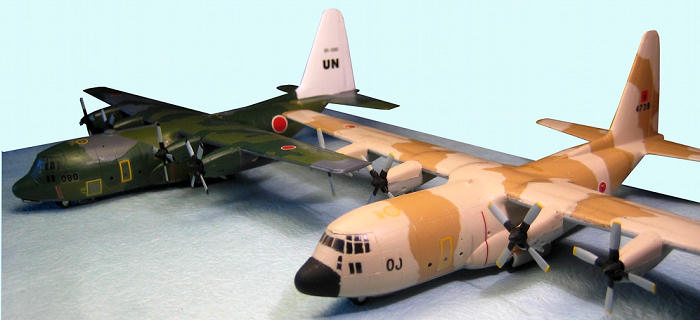
One of the many awful things about war is the
inevitable havoc wreaked upon civilians. Even wars fought by modern Western
militaries lead to accidental civilian deaths, and modern strategy often
requires the destruction of targets that civilians have a hard time living
without. To cut off the enemy's ability to fight, power-stations, bridges,
and communications facilities are frequently bombed.
This helps bring the combat phase to an earlier conclusion - if all goes to
plan - but it does leave a
heavily damaged infrastructure which usually struggles to meet the needs of
the people who still live in the country and still need access to food,
water and medical supplies and later, houses, jobs and a functioning
society.
That's where the reconstruction troops and international aid teams come in.
They don't always get the coverage, positive or negative, that the combat
troops get, and when the eyes of the world have left for the next global
crisis, they are still there
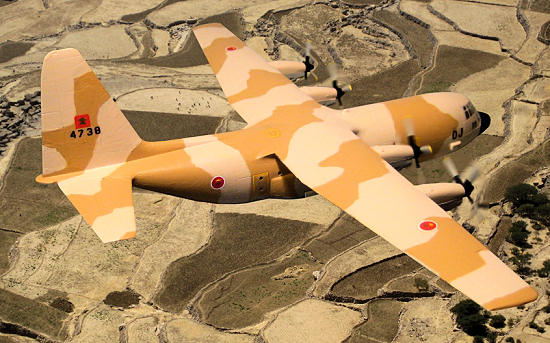 working
day by day to restore normality to civilian life. The challenges are great:
despite the presence of protective troops, they often face insurgent attacks
or criminal gangs. There is widespread official corruption to deal with,
complicated post-war politics as factions jostle for power, sometimes
landmines and other dangers remain, and of course there are the pressing
problems of homelessness, disease, water and food shortages. That's before
they even settle in for the long haul of rebuilding the damaged
infrastructure.
working
day by day to restore normality to civilian life. The challenges are great:
despite the presence of protective troops, they often face insurgent attacks
or criminal gangs. There is widespread official corruption to deal with,
complicated post-war politics as factions jostle for power, sometimes
landmines and other dangers remain, and of course there are the pressing
problems of homelessness, disease, water and food shortages. That's before
they even settle in for the long haul of rebuilding the damaged
infrastructure.
One of the most important tools for reconstruction efforts is the humble
cargo plane. They haul the supplies and people, and they can land on
damaged or poorly-prepared airfields, or just parachute supplies over a
village or town. Many hungry people all over the world must have looked with
hope to the sky as a huge cargo plane flew over, pallets of supplies
floating down on big white chutes to relieve, just for a while, the hardship
and fear of post-conflict or natural disaster situations.
In the long history of humanitarian airlifts, no cargo plane has been more
ubiquitous than the legendary C-130 Hercules. Well over 2,000 of these
workhorses have been built, and it is one of only a few aircraft to be in
service more than 50 years after its first flight
and the only one still in production
after that long. Its user roll-call is literally an
A to Z of world airforces - everyone from Algeria to Zambia has used the
Hercules and, silly as it sounds, a Hercules has served with a country
starting with every other letter of the alphabet too:
http://en.wikipedia.org/wiki/C-130_Hercules#Operators
(No country names start with W or X). The C-130 has performed countless
missions - routine cargo runs, humanitarian airlifts, paratroop drops,
air-to-air refueling, polar resupply, special warfare operations, heavy
gunship missions, fire-fighting, atmospheric tests, airborne recovery of
film canisters dropped from space, and even pulled off 21 landings on an
aircraft carrier.
The first of two Hercules in my review is C-130H 85-1080 of the Japan Air
Self-Defence Force. This Hercules and one other participated in the first
phase of Japan's contribution to the humanitarian effort that followed the
war in Iraq. These two planes, based at Komaki, flew a series of missions
between Italy and Jordan in mid-2003,
before Japan's parliament passed laws allowing the JASDF to fly into Iraq
itself. They shuttled supplies from the World Food Program base in Italy to
a staging airfield in Jordan, where other allied nations flew
(or trucked) the supplies into Iraq. The two planes
were finished in a two-green and grey tactical scheme, but with a big white
tail and bold "UN" markings to indicate the nature of the mission.
Later, under the new laws, the
JASDF was able to fly directly into Iraq. The C-130s used for those missions
formed the JASDF's Iraq Reconstruction
Support Airlift Wing. They were painted an overall
blue-grey, presumably because the threat within Iraq was
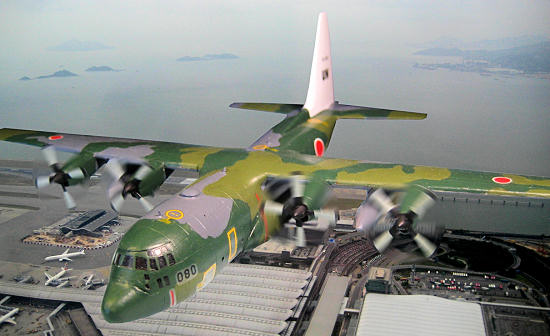 much
greater than the Italy-Jordan runs, and the grey was more suited to Iraq's
landscape than the green-grey of the normal Japanese Hercules. This is the
scheme shown on the box-top photo.
much
greater than the Italy-Jordan runs, and the grey was more suited to Iraq's
landscape than the green-grey of the normal Japanese Hercules. This is the
scheme shown on the box-top photo.
More than 3,600 JASDF personnel served in the Iraq
Reconstruction Support Airlift Wing, which worked with the USAF 386th Air
Expeditionary Wing, as well as personnel from Korea and Australia.
The wing flew hundreds of humanitarian supply missions into Iraq between
March 2004 and December 2008. It achieved its 800th flight in November
2008.
The second of my Hercules is
a Moroccan C-130H. I chose this scheme because I wanted something more
colourful than the overall grey of the second Japanese version that came
with the kit. Some guys on the forum responded to my request for ideas with
a range of interesting-looking desert schemes, including an RAF Herc, as
well as Saudi, Omani and UAE examples. But getting the markings for these
in 1/200 wasn't going to be easy. Inspired by those ideas, I eventually hit
upon the Moroccan version, because Morocco's national markings are based on
a red circle. This meant I could use the Japanese markings as a starting
point. I explain that in more detail below.
Morocco has a fleet of fewer than 20 C-130Hs.
Most are in cargo configuration but a few are used as tankers and a few for
surveillance. In 2009's African Lion exercise with the USMC the Moroccan Air
Force practiced tactical flying and air-to-air refueling its F-5 fighters.
The Moroccan C-130s get around a lot -
airliners.net
has pictures of them in the UK, France and even Brazil.
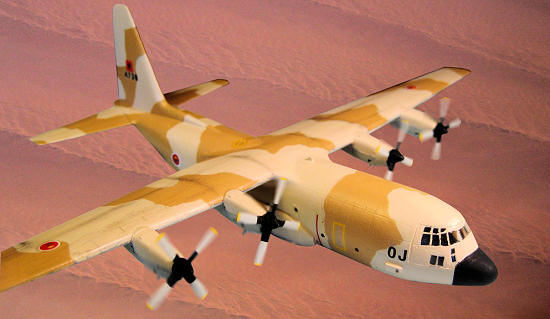 Hasegawa's
1/200 Hercules is not new, but it is a good little kit that fits well and
has nicely moulded details and engraved panel lines. The cargo bay door can
be posed in the open position. There have been at least five boxings that I
know of, and probably many more. The US C-130H boxing is
previewed right here on
MM.
Hasegawa's
1/200 Hercules is not new, but it is a good little kit that fits well and
has nicely moulded details and engraved panel lines. The cargo bay door can
be posed in the open position. There have been at least five boxings that I
know of, and probably many more. The US C-130H boxing is
previewed right here on
MM.
There is also a version of
the AC-130 gunship Hercules, a different USAF boxing, and a JASDF version.
I picked up the "JASDF 2004" special edition, which contains two kits, on
sale at UML in Hong Kong.
Inside you get the basic
C-130 sprues, one set in a blue, almost purple plastic and the other in a
more common light grey. The parts are clean and crisp and I don't recall
any blemishes or sink marks in obvious places. Each Hercules comes with the
underwing tanks and nicely detailed main wheel bays. There is no interior
detail in the main hold, so if you pose the door open you'll want to be cool
with the basics, or scratch up some cabin features.
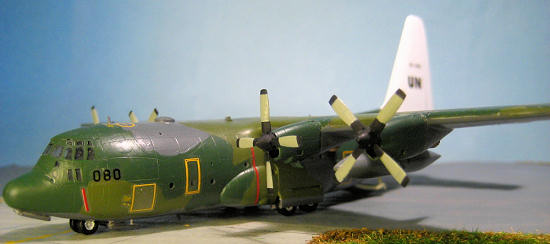 Building
these things was a breeze. I painted the interiors and then just glued it
all together. I used nose weight, and I think it is needed to get a good
nose-down stance. The fit was straightforward, and just a little bit of
sanding on the major seams was all I needed to get a smooth result. On the
engine nacelles, a little extra work is needed, but still, it is nothing
more than a bit of sanding. I didn't use any putty on these models.
Building
these things was a breeze. I painted the interiors and then just glued it
all together. I used nose weight, and I think it is needed to get a good
nose-down stance. The fit was straightforward, and just a little bit of
sanding on the major seams was all I needed to get a smooth result. On the
engine nacelles, a little extra work is needed, but still, it is nothing
more than a bit of sanding. I didn't use any putty on these models.
On the JASDF aircraft, I decided to build the cargo bay door in the open
position, so I used some plastic card to build a ceiling into the rear part
of the fuselage, and I made a floor on the cargo door - nice and flat so
trucks can drive in and out. For a while I thought about adding some further
detail in this area, but eventually changed my mind.
The clear canopy fits like a glove, and the undercarriage goes together
simply (once you've painted 12 wheels).
The kit options are the three-tone camouflaged Hercules or the overall
blue-grey Hercules, both from JASDF's 401st Squadron, 1st Air Transport
Group at Komaki AFB in Nagoya. The blue-grey is an 80-20 mix of Mr Color
323 light blue and flat white.
I painted my JASDF Hercules in the other scheme, brush-painting Mr Color
enamels following the instructions. The dark grey is Mr Color 305 grey
FS36118, the light green is Mr Color 303 green FS34102 and the dark green is
Mr Color 302 FS34092. I used my Tamiya acrylic gloss white for the tail,
although the kit provides a white decal for that too. I used Tamiya XF-14 JA
Grey for the cargo hold in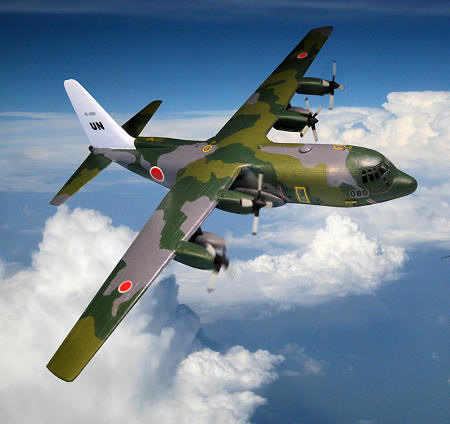 terior.
To me, it is close enough to the pale green interior colour I saw in photos.
terior.
To me, it is close enough to the pale green interior colour I saw in photos.
The Moroccan C-130 is also mostly painted with Mr Color enamels. The
underside is Mr Color 11, Light Gull Grey. The linen colour is Mr Color 45
"sail colour" and the tan is Mr Color 19 "sandy brown". I used Tamiya
acrylic for the matt black areas.
So much for the painting. What about the decals? These Hasegawa decals are
okay, and go on easily enough. They detach from the backing paper very
quickly once in the water - literally in seconds. There's nothing to report
about the JASDF decals. They look more silvery in the photos than in real
life, thanks to the fluro lighting I used.
To make my Moroccan C-130, I used the spare Japanese roundels and painted a
small blob of yellow on each one to represent the crown motif. Then I used a
very fine brush and a dull green and added an indication of the five-point
star that appears on these markings. It is deliberately meant to be an
impression, not an exact copy, but unless you look at it with a magnifying
glass, I think it looks the part. The tail number and nose code were made
from spare lettering and numbering I had in the decal pile. Finally, the
red square and star on the tail were made in the same way - a scrap of red
decal and a light touch with the green paint. The yellow escape-hatch rings
on top of the Moroccan plane really should be grey, but I just used the ones
from the kit.
The website for the Japanese
Iraq Reconstruction Support Airlift Wing has a
special section all about the troops washing their Hercules in the desert,
so I guessed that my plane should be clean as a whistle. The Moroccan
plane, on the other hand, needed a bit of weathering judging by the photos
on
airliners.net.
So I tackled it with a bit of dark grey artist pastels rubbed in with a
tissue or painted on with an old brush.
It's
easy to overdo this, of course, but what I did does match a few pictures I
have seen.
Three cheers for the Hercules! And huzzah for Hasegawa's twin-packs.
Another great small scale kit from Hasegawa, easy to build, good value if
you can find the two-pack on sale, and offering a huge range of potential
colour schemes to the creative modeller. I was lucky enough to ride in the
back of a Hercules twice in my life - once in a C130E and the other time in
an H. These little kits are a cool way to remember that at a scale you can
manage in a small apartment.
Courtesy of me and my eagle-eye for sale items, especially cargo planes.
wikipedia
www.airliners.net
If you would like your product reviewed fairly and quickly, please
contact the editor or see other details in the
Note to
Contributors.
Back to the Main Page
Back to the Review
Index Page 2020


 working
day by day to restore normality to civilian life. The challenges are great:
despite the presence of protective troops, they often face insurgent attacks
or criminal gangs. There is widespread official corruption to deal with,
complicated post-war politics as factions jostle for power, sometimes
landmines and other dangers remain, and of course there are the pressing
problems of homelessness, disease, water and food shortages. That's before
they even settle in for the long haul of rebuilding the damaged
infrastructure.
working
day by day to restore normality to civilian life. The challenges are great:
despite the presence of protective troops, they often face insurgent attacks
or criminal gangs. There is widespread official corruption to deal with,
complicated post-war politics as factions jostle for power, sometimes
landmines and other dangers remain, and of course there are the pressing
problems of homelessness, disease, water and food shortages. That's before
they even settle in for the long haul of rebuilding the damaged
infrastructure. much
greater than the Italy-Jordan runs, and the grey was more suited to Iraq's
landscape than the green-grey of the normal Japanese Hercules. This is the
scheme shown on the box-top photo.
much
greater than the Italy-Jordan runs, and the grey was more suited to Iraq's
landscape than the green-grey of the normal Japanese Hercules. This is the
scheme shown on the box-top photo. Hasegawa's
1/200 Hercules is not new, but it is a good little kit that fits well and
has nicely moulded details and engraved panel lines. The cargo bay door can
be posed in the open position. There have been at least five boxings that I
know of, and probably many more. The US C-130H boxing is
previewed right here on
MM.
Hasegawa's
1/200 Hercules is not new, but it is a good little kit that fits well and
has nicely moulded details and engraved panel lines. The cargo bay door can
be posed in the open position. There have been at least five boxings that I
know of, and probably many more. The US C-130H boxing is
previewed right here on
MM. Building
these things was a breeze. I painted the interiors and then just glued it
all together. I used nose weight, and I think it is needed to get a good
nose-down stance. The fit was straightforward, and just a little bit of
sanding on the major seams was all I needed to get a smooth result. On the
engine nacelles, a little extra work is needed, but still, it is nothing
more than a bit of sanding. I didn't use any putty on these models.
Building
these things was a breeze. I painted the interiors and then just glued it
all together. I used nose weight, and I think it is needed to get a good
nose-down stance. The fit was straightforward, and just a little bit of
sanding on the major seams was all I needed to get a smooth result. On the
engine nacelles, a little extra work is needed, but still, it is nothing
more than a bit of sanding. I didn't use any putty on these models. terior.
To me, it is close enough to the pale green interior colour I saw in photos.
terior.
To me, it is close enough to the pale green interior colour I saw in photos.